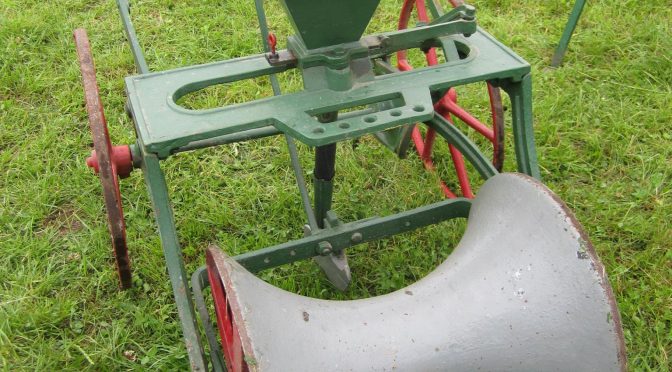James Headrick wrote a comprehensive account of the implements and machines used in the county of Angus for the Board of Agriculture and Internal Improvement in 1813. While aspects of his account are noted for other counties in Scotland, there were also distinct features for the county of Angus. His account is worth quoting at length:
“Ploughs
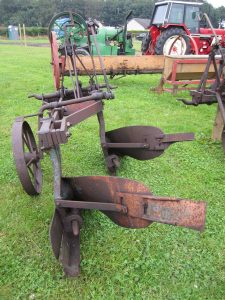 In the northern district, the Old Scotch plough is still occasionally used, and it is an instrument well adapted for breaking up waste land, that is encumbered with the roots of shrubs, or with stones. At no remote period, it was usual to yoke four, or six horses abreast in this plough. The driver walked backwards before the horses, and struck them in the face to make them come forward. Now, this plough is commonly drawn by four, sometimes by six horses, which are yoked in pairs, and the driver walks beside them. But, excepting for the purposes already specified, the plough which was first invented by the late Mr Small near Dalkeith, and from him named Small’s plough, is universally used. It has a cast iron mould-board, which is sometimes made in parts, so that the portion which is most exposed to friction may be replaced, without needing to replace the whole. There are several variations in the form of the old board, so that those preferring those which are concave, and some this which are convex, or different intermediate forms between these extremes. This plough is constructed by skilful tradesmen in all parts of the county, and
In the northern district, the Old Scotch plough is still occasionally used, and it is an instrument well adapted for breaking up waste land, that is encumbered with the roots of shrubs, or with stones. At no remote period, it was usual to yoke four, or six horses abreast in this plough. The driver walked backwards before the horses, and struck them in the face to make them come forward. Now, this plough is commonly drawn by four, sometimes by six horses, which are yoked in pairs, and the driver walks beside them. But, excepting for the purposes already specified, the plough which was first invented by the late Mr Small near Dalkeith, and from him named Small’s plough, is universally used. It has a cast iron mould-board, which is sometimes made in parts, so that the portion which is most exposed to friction may be replaced, without needing to replace the whole. There are several variations in the form of the old board, so that those preferring those which are concave, and some this which are convex, or different intermediate forms between these extremes. This plough is constructed by skilful tradesmen in all parts of the county, and 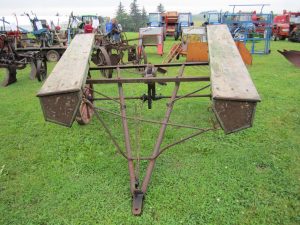 cost L2 or L2 6s. It is drawn by two horses, which are generally so trained that they obey the ploughman’s voice, and need neither reins or driver. oxen were formerly very much used in the plough; but they have been almost entirely given up on corn farms, as horses are more expeditious, and fit for many purposes for which oxen are ill adapted. Even the tax upon plough horses has not operated in favour of oxen, as horses are more general now, than they were before that tax was imposed. The ploughmen here are very skilful, and many of them have been carried to Ireland, and other districts, in order to improve their modes of ploughing.
cost L2 or L2 6s. It is drawn by two horses, which are generally so trained that they obey the ploughman’s voice, and need neither reins or driver. oxen were formerly very much used in the plough; but they have been almost entirely given up on corn farms, as horses are more expeditious, and fit for many purposes for which oxen are ill adapted. Even the tax upon plough horses has not operated in favour of oxen, as horses are more general now, than they were before that tax was imposed. The ploughmen here are very skilful, and many of them have been carried to Ireland, and other districts, in order to improve their modes of ploughing.
Harrows -These are of three sorts, in this county: 1. the break harrow, is a strong and weighty instrument, and to give it great efficacy, is sometimes loaded. It consists of four heavy and strong hills, connected by cross spars. The teeth extend from six to eight inches below the hills; are bent a little forward; are of an angular shape, so as to resemble small coulters; and are so strongly wedged in the hills that they cannot turn. This instrument is drawn at one corner by two, three, or sometimes four horses yoked abreast, according to the soil on which it operates. Its teeth, as indeed of all the other harrows used, are so placed as to cut the land at equal distances. Its use is to break up and reduce adhesive soils while under fallow, and to tear up root-weeds. when the teeth are chocked by these weeds, the driver has a rope fastened to the rear of the harrow, with a cross stock, by which he can lift it up, and cause it to discharge its contents on the surface. In some cases, the break-harrow is in the form of a triangle, with a pair of stilts behind, by which the driver can press it deep into the ground, or can raise it so as to make it discharge the weeds it had collected. This latter construction seems to be a great improvement; but the break-harrow is not yet so universally used in this county as its merits seem to require.
2. The common harrow is the one used for covering in the seed, and for destroying annual weeds in fallows. They are drawn with one horse to each. A pair costs from L1 10s to L2 2s.
3. The grass-seed harrow, has teeth much shorter, and the instrument is not so strong as the common harrow. It is used for covering grass and clover-seeds; but sometimes the common harrow is used for this purpose; and sometimes a mass of thorn bushes, loaded by a weight.
Rollers- These are universally used, and they are sometimes constructed of a log of hard wood; but more generally of a sandstone fashioned into the form of a cylinder. In a few cases they are composed of old cart wheels, the rims of which are covered with spars of wood, and an iron axle passing through the centre, serves to connect the roller with the frame by which it is dragged along. This kind has commonly a hopper above, by which can be loaded at pleasure, or by which stones can be conveyed from the land. Other rollers consist of broad cylinders of cast iron, which seem to be the most effectual of any. The prices of these instruments vary with the materials, and the mode of their construction.
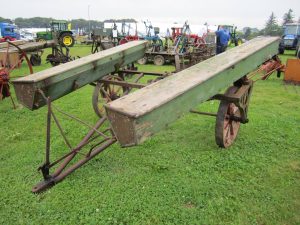 Drill barrows. These are used for sowing turnip, and other small seeds, in rows, or drills. For this purpose, some of the small farmers use a small triangular box of tin plate, the form of a hopper, into which the seed is put, and closed with a lid. This is fastened to the lower end by a stick which is shaken with the hand along a small ridge previously formed on the top of the drill, while the seed drops through a small aperture in the bottom of the top box.
Drill barrows. These are used for sowing turnip, and other small seeds, in rows, or drills. For this purpose, some of the small farmers use a small triangular box of tin plate, the form of a hopper, into which the seed is put, and closed with a lid. This is fastened to the lower end by a stick which is shaken with the hand along a small ridge previously formed on the top of the drill, while the seed drops through a small aperture in the bottom of the top box.
The single drill-barrow is pushed along the drill with the hand, the drills being previously smoothed by the common roller. It forms a small rut for the reception of the seed; while a rake and small roller follow to cover it in. Other machines of this sort, sow two, three, and sometimes four drills at a time; have a roller in front to smooth the drills, and another behind to cover the seed; are drawn by a single horse, who walks in the hollow between two drills, and are guided by the ploughman, who walks behind. These machines cost various prices, from about one to six guineas.
Hoeing machines-These are, 1. the scarifier, which is a sort of Dutch hoe mounted upon a small plough, and drawn by a single horse. It cuts the annual weeds about two inches below the surface, and causes them to wither by the heat of the sun. Sometimes this instrument is composed of three angular hoes placed in the angles of a triangle, which form is preferred, as the two rear hoes can be varied in distance according to the breadth of the drills. These machines are regulated by wheels.
2. The double mould board plough, is a small plough, drawn by a single horse, whose mold-boards are moveable upon hinge, so that they can be extended at pleasure, by bars of iron crossing the rear of the plough. It is used for paring away the earth from the rows of drilled crops, and throwing it into the hollows between the drills. After the weeds are destroyed, the mold-boards being extended, it is used for throwing back the earth to the roots of the plants. The common hoe, and the hand, are used for eradicating such weeds as cannot be reached by these machines.
Carts-In proportion as the roads have been improved, single horse carts have become much more frequent than formerly. The double horse cart has one advantage in miry roads, that when the shaft horse and the cart are sticking in a puddle, the trace horse has generally cleared it, and can exert himself to drag the rear horse, together with the cart, out of the mire. but on firm roads, it is clearly ascertained that two horse, in separate carts,w which one many can easily manage, can draw a third more weight, with less injury to themselves or to the road, than two horses in one cart. The carriers betwixt Glasgow and Edinburgh commonly convey from a ton to thirty hundred hundred, upon a single horse cart; and they perform the journey of forty-two miles in about twenty-four hours. In this county, a single horse cart, or coup, as it is commonly called, is about five feet five inches in length, three feet five inches in breadth, and besides seventeen or eighteen inches in height. The price of a cart, for a single horse, or for a pair, varies from about L10 to L16, including the wheels, iron axle, and other appendages. The harness for a pair of horses, may cost about L5 more. The boards of the cart are now generally fastened to the shafts and spars by screwed bolts, which keep them much firmer than can be done with nails; and one set of these bolts will outlast several carts. For carrying corn in the straw, or hay, each cart is provided with a frame of wood, which is laid over its mouth, and enlarges the base on which the load is built. The large wagons which prevail in England, are not adapted for this hilly country; and it is demonstrable, that even on level roads, if they be firm below, single horse carts are the most economical way of applying animal force in the conveyance of goods.
 Threshing mills-These are now very general in this county, on all corn farms which exceed a hundred acres in extent. When the flail is used for separating the corn from the straw, the barman gets one boll in twenty-one without, or one boll in twenty-five with, one meal a day, But the threshing mill excels in expedition, and its superiority in point of clean threshing is such, that the barman’s allowance is supposed to be more than saved by employing it. Many attempts were made to construct threshing mills, on various principles; but the one which has succeeded best, and which, with only one exception, is universally used here, is that which was invented by Mr Meikle, when he was employed in constructing machinery by the late Mr James Stein, distiller at Kilbagie, near Clackmannan. This machine is so very common, that all description of it seems unnecessary. In this county threshing mills are commonly moved by horses; but where opportunity occurs, water is always preferred. A few of them are moved by wind, and there may be one or two near the coast moved by steam. The latter are used for grinding, as well as threshing corn.
Threshing mills-These are now very general in this county, on all corn farms which exceed a hundred acres in extent. When the flail is used for separating the corn from the straw, the barman gets one boll in twenty-one without, or one boll in twenty-five with, one meal a day, But the threshing mill excels in expedition, and its superiority in point of clean threshing is such, that the barman’s allowance is supposed to be more than saved by employing it. Many attempts were made to construct threshing mills, on various principles; but the one which has succeeded best, and which, with only one exception, is universally used here, is that which was invented by Mr Meikle, when he was employed in constructing machinery by the late Mr James Stein, distiller at Kilbagie, near Clackmannan. This machine is so very common, that all description of it seems unnecessary. In this county threshing mills are commonly moved by horses; but where opportunity occurs, water is always preferred. A few of them are moved by wind, and there may be one or two near the coast moved by steam. The latter are used for grinding, as well as threshing corn.
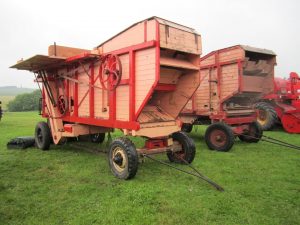 Many attempts have been made to construct threshing mills with a one-horse power, so as to accommodate small farms. But these machines have not hitherto proved efficient with less than a four-horse power;a nd the generality of them in this county, are moved by six horses; or by a powerful equal to their strength. Such machines cost from about L140 to L180.
Many attempts have been made to construct threshing mills with a one-horse power, so as to accommodate small farms. But these machines have not hitherto proved efficient with less than a four-horse power;a nd the generality of them in this county, are moved by six horses; or by a powerful equal to their strength. Such machines cost from about L140 to L180.
An artist at Arbroath has lately introduced into that neighbourhood, a threshing machine which is moved by two horses, and seems to do the work very well; only it does not thresh so much as a four, or six-horse, machine, in a given time. In his machine, the length of the drum, or trundle, to which the beaters are fixed, is diminished, so that they cannot take in more corn at a time, than is proportioned to the power of two horses. The wheels and moving powers are all of cast iron, and it is merely Meikle’s machine reduced in its 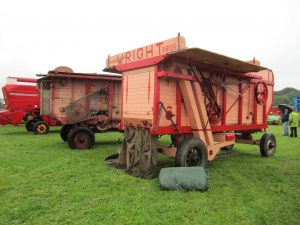 dimensions. This machine costs from L50 to L60. It seems probable, that by a still farther contraction of the drum, or trundle, these may be made to do sufficient work with one horse, or even with any inferior power but it must be understood, that the quantity threshed in a given time, must always be proportioned to the original power applied. Thus Mr Milk’s mill may be accommodated to small farms.
dimensions. This machine costs from L50 to L60. It seems probable, that by a still farther contraction of the drum, or trundle, these may be made to do sufficient work with one horse, or even with any inferior power but it must be understood, that the quantity threshed in a given time, must always be proportioned to the original power applied. Thus Mr Milk’s mill may be accommodated to small farms.
The ingenious Mr Stirling at Howmuir, near Forfar, has adopted a threshing mill, which bids fair to succeed on small farms. It was first invented in the neighbourhood of Dunblane, and the mode by which it is put animation is exactly the same with that by which small corn mills are moved in the district of Uig, Island of Lewis, and in some other Hebridean Isles. It consists of a perpendicular shaft or axle, moveable on a pivot below, and having another pivot inserted into a box in the upper part of the building. This upright shaft may be about twenty-five or thirty feet long, according to the height of the water-fall which puts the machine in motion. On the lower part of this shaft there is fastened a trundle of cast iron, about three feet, or two and a half feet diameter, which has thin and broad leaves extending from its centre to the rim which incloses their extremities. One disadvantage of this machine is, that the sheaf is not struck with the same force at all points, as happens with Mr Meikle’s horizontal knockers. For the velocity at different points of the scatters, being as the squares of their distances from the centre of motion, it is evident that the outside of the sheaf will more forcibly struck, than the parts nearer the centre. Another disadvantage is, that they have not yet contrived to make the machine feed itself; and feeding with the hand is subject to inequalities, sometimes the machine having too much, and sometimes too little. It seems, however, to answer well for threshing oats and barley; but it is not so well adapted for wheat. Perhaps this might be remedied, were a method found of making the machine feed itself. The whole expense of the machinery in this instrument does not exceed l20; but there must be a house built for it.”
A super account of the implements and machines used in Angus agriculture in 1813!
The photographs were taken at New Deer show, August 2014.
